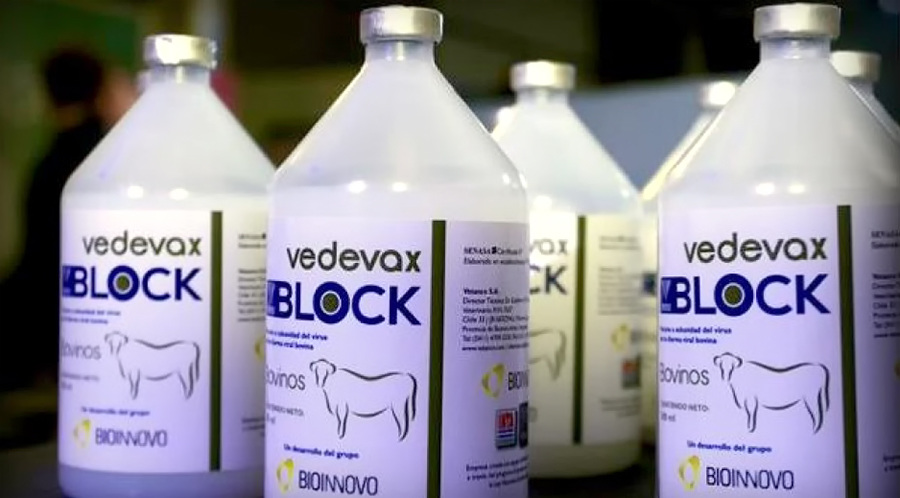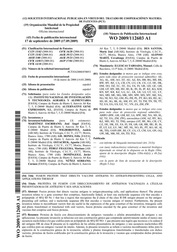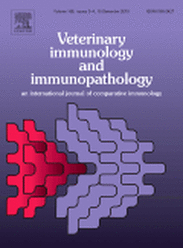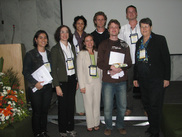Rational Design of Vaccines
Vedevax (2015)
Patented innovation developed in my PhD. thesis (APCH1-E2T) is going to be manufactured and marketed soon.
|
Fusion protein that directs vaccine antigens to antigen presenting cells and applications thereof
Fusion protein that directs vaccine antigens to antigen-presenting cells, and applications thereof. The present invention relates to a gene construct that comprises, functionally linked, at least one nucleotide sequence (A) that encodes a polypeptide of SEQ ID No 1 that has a region that recognizes the β chain of the class II DR antigen present on the antigen-presenting cell surface; and a nucleotide sequence (B) that encodes a vaccine antigen of interest. Furthermore, the present invention relates to recombinant vectors that are useful in the expression of the gene construct of the invention, transgenic cells and plants transformed or transfected with said vectors, fusion proteins encoded by the gene construct of the invention and vaccines that comprise said fusion proteins. [Patent WO/2009/112603]
|
|
|
Expression of a ScFv-E2T fusion protein in CHO-K1 cells and alfalfa transgenic plants for the selective directioning to antigen presenting cells
Bovine viral diarrhea virus (BVDV), a pestivirus of the Flaviviridae family, is an important cause of mortality, morbidity and economical losses of cattle with a worldwide distribution. Subunit vaccines provide the opportunity to develop safe vaccines. However, the challenge is to generate a protective immune response to a cost affordable for veterinary applications. One alternative to solve this problem is to increase the vaccine immunogenicity. A central event in the development of an adaptive immune response is the presentation of the antigens to CD4+ T cells from antigen presenting cells (APCs). In consequence, a way to obtain a more intense specific immune response is to increase the number of MHC-peptide complexes on the surface of APCs. This would be possible by directioning antigens to APCs, fusing them to specific antibodies against APCs´ surface markers. In this work, we report the development of a fusion protein between a single chain antibody fragment (ScFv), recognizing a conserved region of MHC class II molecules, and a truncated form of the E2 glicoprotein (E2T) from BVDV, without its transmembrane domain. The expression systems chosen to express these proteins were mammalian cells (CHO-K1) and plants (Medicago sativa, alfalfa). E2T and ScFv-E2T fusion protein were expressed transiently and stably in CHO-K1 cells, as evidenced by Western blot and ELISA using a monoclonal antibody against E2. They were purified by IMAC (Ion Metal Affinity Chromatography) from cell culture supernatants, resulting in an average final yield of 0.2 mg/L. Alfalfa transgenic plants were generated by infection of petioles with recombinant Agrobacterium tumefaciens, which contained the appropriate gene cloned in a pCAR vector downstream of CsVMV promoter, from Cassava vein mosaic virus. Plants were analyzed for the expression of the proteins by ELISA, and many of them resulted positive. Binding of fusion proteins to the surface of peripheral blood mononuclear cells (PBMCs) from cattle, pig, horse, guinea pig, sheep and goat was studied by flow cytometry. Our results demonstrate that ScFv-E2T expressed in CHO-K1 cells was capable of binding to the surface of PBMCs more intensively than E2T, thus supporting the use of this strategy for delivering vaccine antigens to APCs. Studies comparing the immune responses elicited by both proteins are currently being conducted using a guinea pig experimental model.
|
8th International Veterinary Immunology Symposium (8thIVIS, 2007)
My work "Expression of a ScFv-E2T fusion protein in CHO-K1 cells and alfalfa transgenic plants for the selective targeting to antigen presenting cells", presented at the 8th International Veterinary Immunology Symposium (8thIVIS), held in Ouro Preto (Brazil), was awarded as the second best student poster.
|




